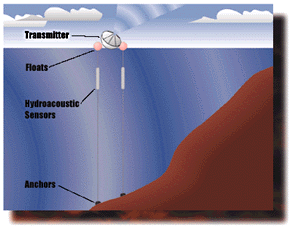
Underwater explosions create an enormous expanding bubble filled with scorching gases. The growth eventually loses momentum, and the water pressure squeezes the gassy globule back down. The internal pressure rebuilds and the gas and water pressure continue this tango, cyclically expanding and contracting the walls of the gas pocket as it rises
According to Lay, a few microphones stationed in the major bodies of
water are all that are needed to listen for this "bubble pulse."
Hydrophones, as they are called, consist of a pressure sensitive floating
two-foot long cylindrical bump of on a hose that can feel sound waves. "Sound
travels extremely well in the ocean," says Lay. "Even small chemical
explosions are extremely loud. An underwater nuclear explosion is likely
to bust everyone's eardrums." But | ||
 |
